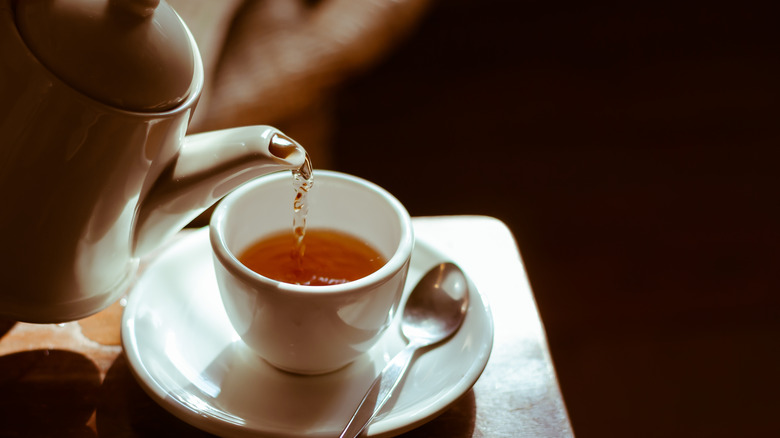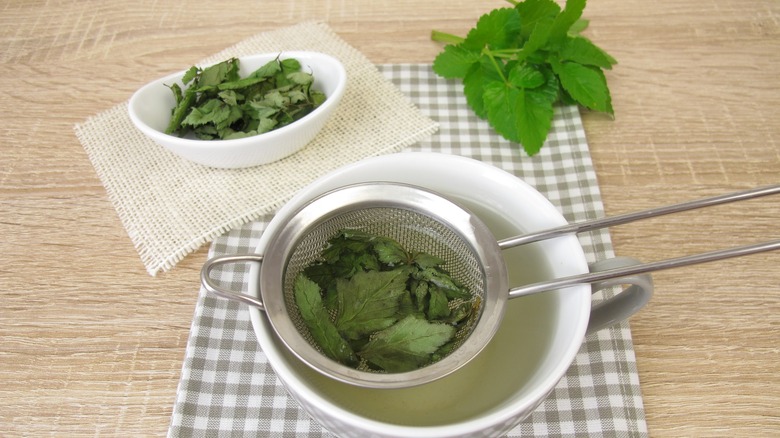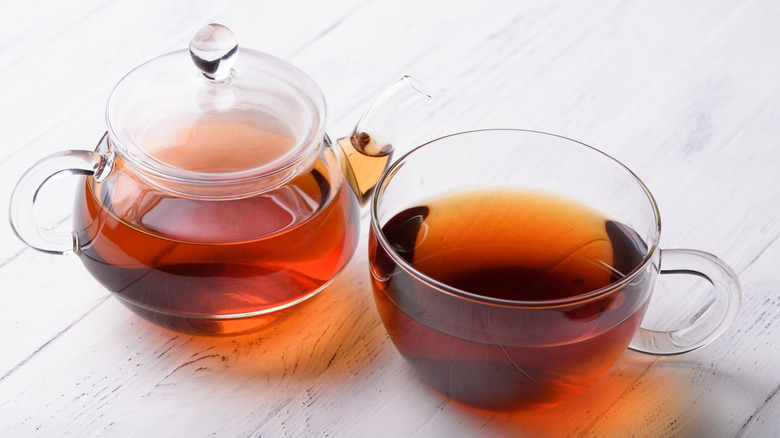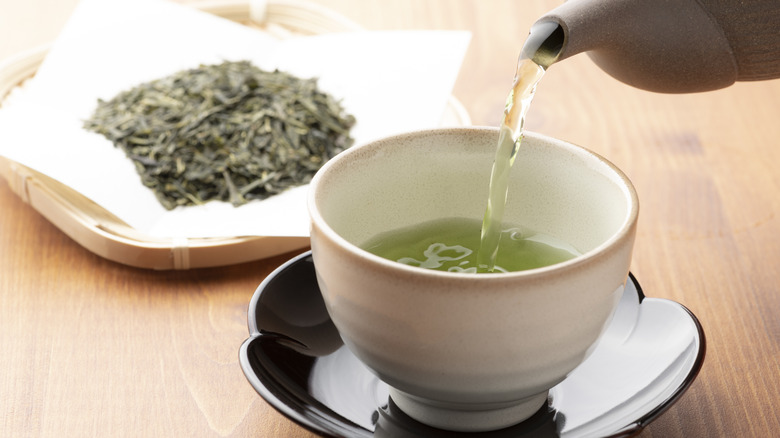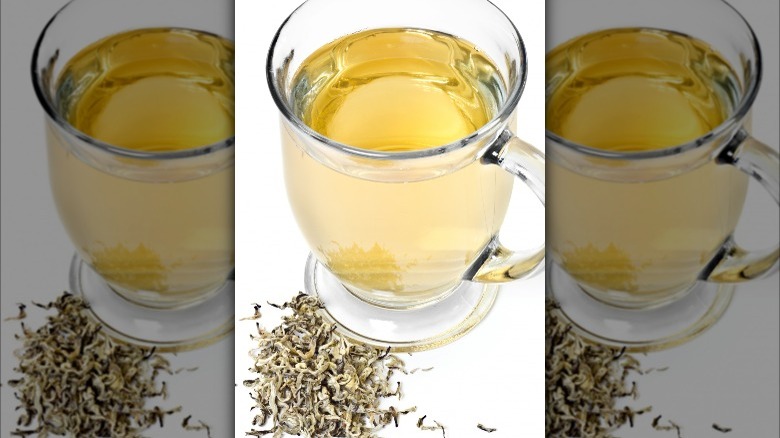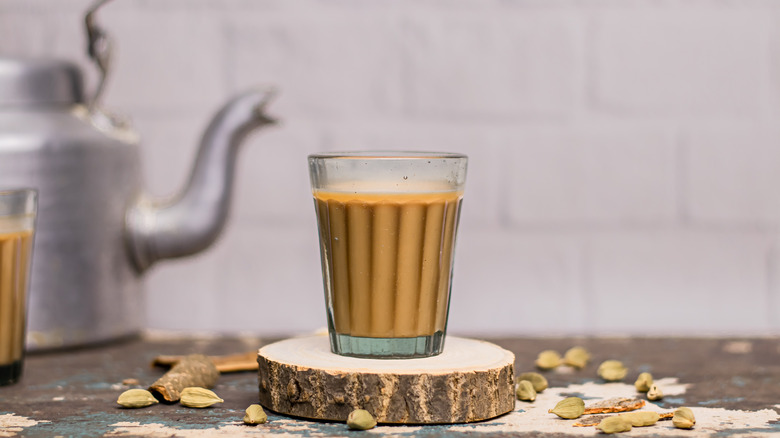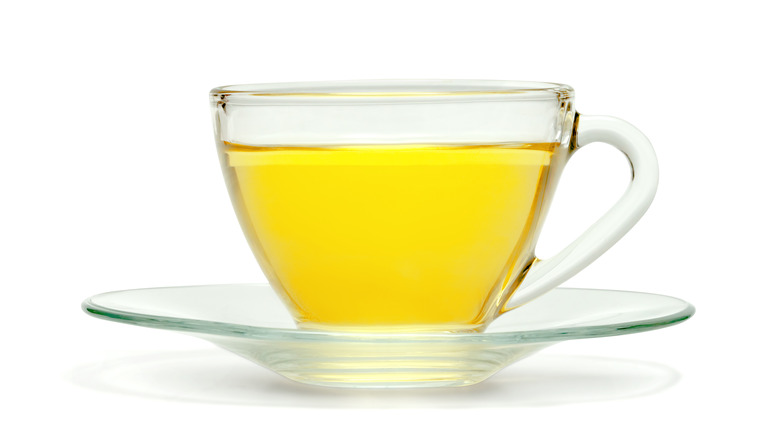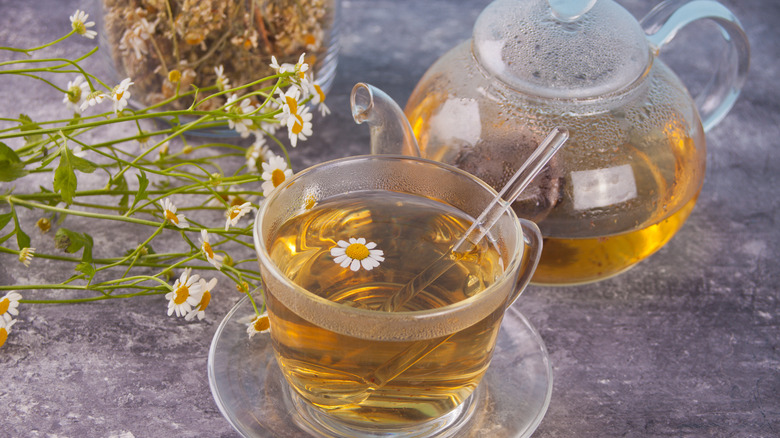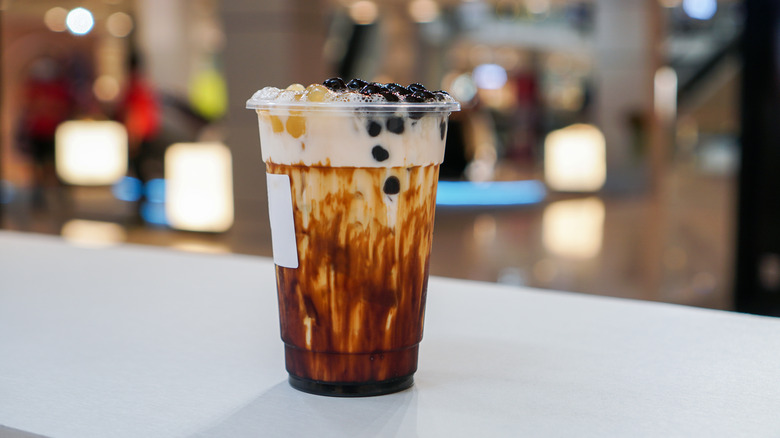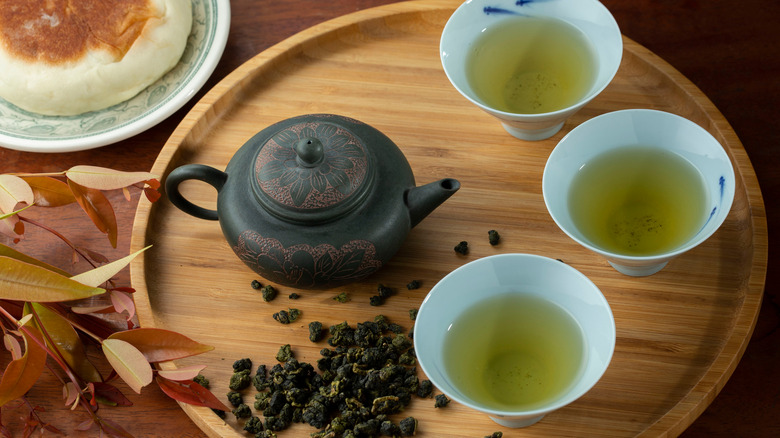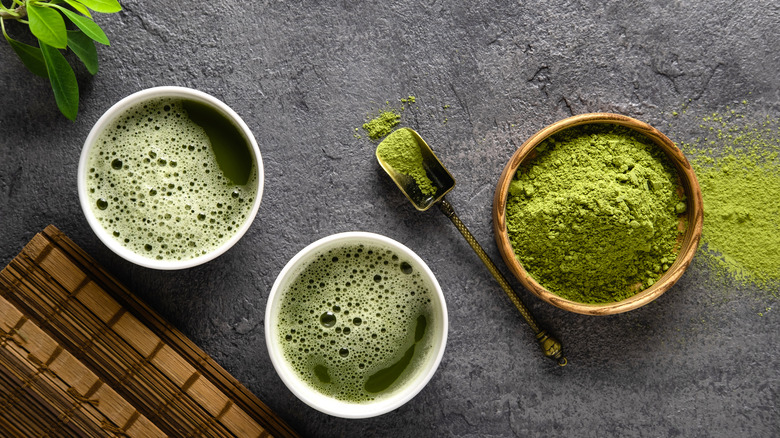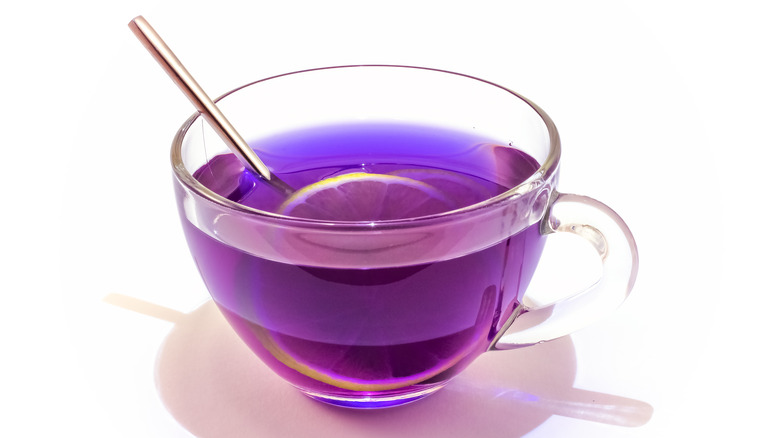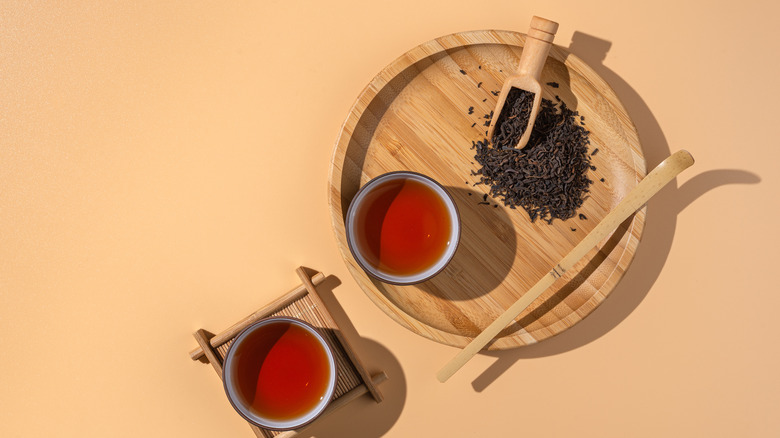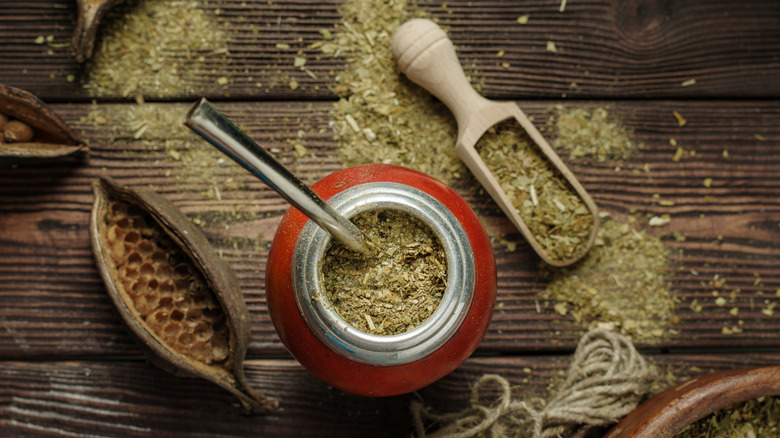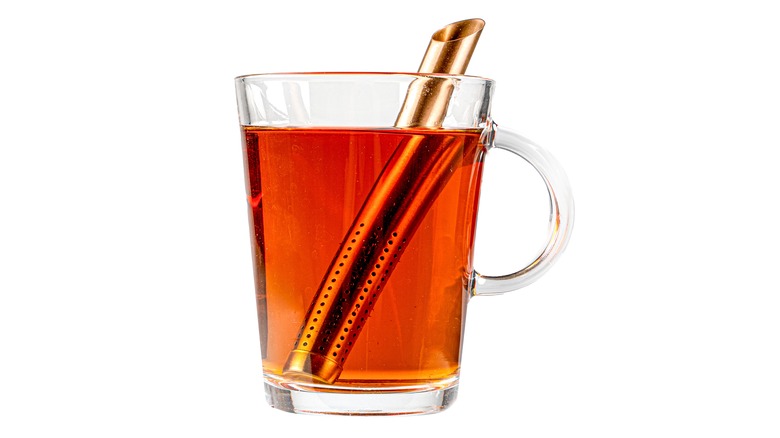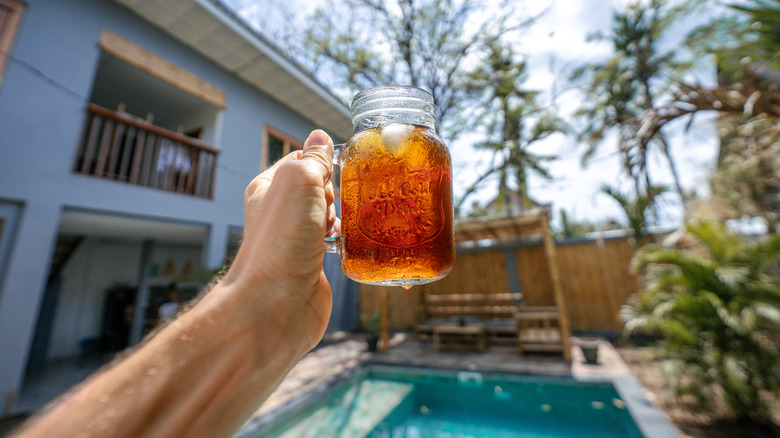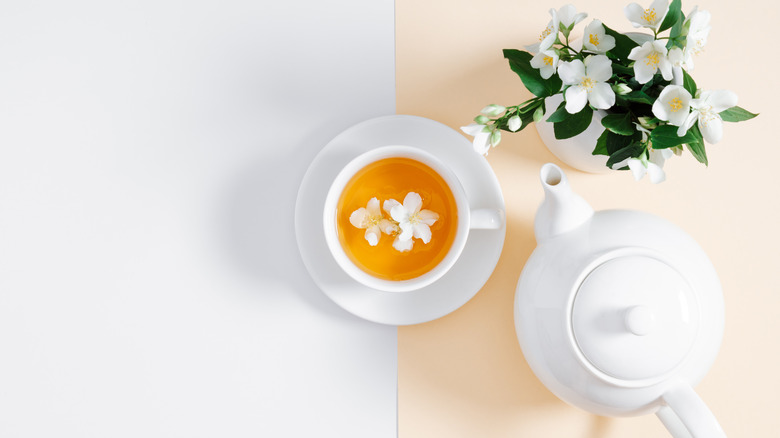15 Types Of Tea, Explained
Tea is a popular beverage for medicinal and cultural purposes around the world. There are over 1,500 varieties of tea available (via UC Davis) to suit almost every palate, whether you enjoy a mild English breakfast tea for a caffeine boost or chamomile tea to put you to sleep at night. Our in-house research revealed that nearly half of consumers use tea bags as their preferred way to make tea, followed by loose-leaf tea strained with a strainer or a tea ball. According to the University of Pennsylvania, tea's high antioxidant potential has linkages to decreasing the risk of inflammatory diseases and cancer, as well as the potential to boost immune function. Plus, there might not be a better drink than a piping hot cup of tea on a cold day.
With the sheer variety of tea types, how do you find the perfect tea for your palate? Here are some of the most popular types of tea you can drink, along with how to best prepare each for optimal flavor notes.
Tea bags versus loose-leaf tea
While most people prefer using tea bags for ease of use, some traditionalists stick to using strainers and loose-leaf tea bags. Tea bags are often made with cheap filter paper — or in some more expensive applications, cotton or silk — and are filled with small shreds of tea leaves and herbs (via MasterClass). Since these tea bags only have to sit in hot water to steep for several minutes, many tea drinkers lean towards tea bags for sheer convenience. Tea bags are also widely available in grocery stores and supermarkets, more so than select types of loose-leaf tea.
Loose-leaf tea is not constrained to a steeping bag. The tea floats either in an infuser or is removed from the water using a strainer once it has finished steeping. Loose-leaf tea provides a slightly more robust flavor than bagged tea, per Masterclass, but it takes longer to prepare and strain. This is because loose-leaf tea is made with whole or broken leaves, while tea bags are usually made with fannings (leaf fragments) or dust from the process of crushing the leaves.
Black tea
Black tea is a full-bodied variety with less herbal influence than green tea or a specific herbal variety, like chai. About 84% of the tea consumed in America is black tea (via Tea Association) and includes sub-varieties like English breakfast, Earl Grey, and Darjeeling. The roots of black tea are farther from the American and English countries where it is most popular; it is believed to have emerged in the 1600s in China (via Hackberry Tea).
The flavors of black tea are tannic and caffeinated, making it a good option for morning and mid-day drinkers. The average cup of black tea contains an average of 47 milligrams of caffeine but can have as much as 90 milligrams (per Healthline), which is more than a green tea. Black tea is most flavorful when brewed between 200 F and 212 F. For a deeper flavor, let your black tea steep for upwards of six minutes. If you prefer weaker tea, steep your tea for about two minutes.
Green tea
Green tea packs a mild caffeine dose of between 20 and 50 milligrams per cup, per Byrdie. Besides a slightly less jittery caffeine experience than black tea or coffee, green tea contains a powerful antioxidant called catechin, an antioxidant known to reduce the risk of some types of cancer (via the National Library of Medicine). Green tea also has numerous other benefits, as identified by Health, including the potential to lower cholesterol and the risk of heart disease.
Green tea originated in the Yunnan Province of China, although it was popularized in Japan in the 1100s when Zen priests started visiting Chinese monasteries. Eventually, green tea was used as a meditation tool for the monks but spread quickly to the rest of Japan. Japan and China remain two of the top green tea-producing countries (via Teatulia).
Green tea has an earthy, nutty, and herbaceous taste, making it a mild tea for most tea drinkers. Smith Tea recommends steeping green tea for three minutes at 185 F for the perfect cup. Unlike black tea, green tea has a much more pronounced flavor and less bitter notes when the tea is added after the hot water to the brewing vessel.
White tea
According to Teatulia, the "white" in white tea refers to the fine white hairs that sit on top of the young tea buds before harvest. Since the leaves for white tea are picked while the plant is young, the flavor is very delicate compared to black or green tea. Additionally, white tea is one of the least oxidized (exposure to oxygen) types of tea that can be processed, thus incurring a soft and almost grassy flavor. White tea has comparatively low caffeine content than other types of tea at 15 to 30 milligrams per cup (via the Garfield Medical Center).
White tea was initially cultivated during the early Chinese dynasties (600 to 1300 BC) when the emperors gifted fine teas. As modifications and adaptations were made to transportation systems, white tea began appearing outside of the provinces in which it was primarily grown.
Due to its age, white tea is almost exclusively found in loose-leaf teas rather than tea bags. Per the Sencha Tea Bar, you'll want to bring the water temperature to around 170 F to brew the perfect cup of white tea. Two tablespoons of loose-leaf white tea for every six ounces of water is the standard.
Chai
Chai is one of the most delectable types of tea available, and "chai" is the Hindi word for "tea." Oregon Chai notes that the mix of Assam black tea and spices dates back over 5,000 years to South Asia, when the beverage was consumed almost exclusively for medicinal purposes.
Chai can also be referred to as masala chai, which must include four major ingredients: strong black tea, your choice of milk, a sweetener, and spices including cardamom, black pepper, ginger, cinnamon, and fennel. According to Prana Chai, because chai is a combination of ingredients besides tea, the caffeine concentration is between 20 and 100 milligrams.
There are many ways to prepare chai tea, but the most common bases include sweetened condensed milk or plain milk. As noted by TeaSource, you should use one tablespoon of Assam black tea for each cup of chai. The leaves are added to boiling water for two to four minutes before straining and mixing in the seasonings, sweetener, and milk of choice.
Yellow tea
According to Mansa Tea, yellow tea is derived from the yellow-hued tea from the Camellia sinensis plant. Its flavor is more floral and fruity than green tea, and it's most often sold in China. The use of yellow tea in Chinese ceremonies dates to the Tang Dynasty, between 618 and 907. The tea's color indicates wealth and royalty, so it was almost exclusively presented to noble emperors.
Yellow tea differs from other types of tea because it undergoes a "micro-fermentation" process called menhuang. Mansa Tea notes that yellow tea is dried before it's wrapped in paper and allowed to ferment slowly, thus developing a mild sweetness. One cup of yellow tea equates to about 64 milligrams of caffeine.
To make this variety of tea, Mansa Tea recommends heating the water to 190 F before adding three grams of loose-leaf tea for every 12 ounces of water. The tea only needs to infuse for about three minutes and can be infused up to three more times afterward.
Chamomile tea
Chamomile tea is typically associated with warmth and bedtime. According to the Wise Ape Tea Company, chamomile was used by the early Egyptians and the Romans as a remedy for colds and salves. In Greek, chamomile roughly translates to "ground apple" (via Vicony Tea Directory). This name reflects chamomile's flavor, which has an apple-like and floral undertone. There are two varieties of chamomile — Roman chamomile and German chamomile —and the flowers and buds of this plant are harvested and dried to make tea.
Since chamomile is a herbal tea, it does not contain any caffeine. The relaxing tea can be found in ground and loose-leaf forms and is often combined with other herbs like peppermint or mint for a more intense earthy flavor. To make chamomile tea, two to three tablespoons of chamomile flowers are combined with a cup of boiling water for about five minutes before straining.
Bubble tea
Bubble tea (or "boba") is not a typical tea — it's more of a confection. Bubble tea emerged in Taiwan during the 1980s and has since become a viral media sensation. The most common "original" bubble tea flavor is milk tea, which includes black tea, milk powder, and sugar. Variations of boba include green, oolong, and matcha teas. The other ingredient that sets boba tea apart from other teas is tapioca pearls, which are usually soaked in a sweet syrup or brown sugar for a sugary boost.
With the sheer variation in boba flavors, it's hard to pinpoint an exact flavor — especially because boba offers more of a textural chew than a flavor. The actual preparation methods also vary, but overall, the tea component of this beverage is not finicky. You can counteract oversteeping the tea by adding milk and sweetener. Drink Pearly notes that boba has an average of 50 milligrams of caffeine per cup but can be as low as 20 milligrams (or none, for some varieties like taro).
Oolong tea
Oolong tea is a wide variety with a flavor between green and black tea. Black teas are fully oxidized, meaning that it has the most robust flavor, and green tea is very lightly oxidized, so it has a more earthy undertone. Oolong tea is somewhere in the middle, with oxidation between 8% and 85%, meaning that the tea presents floral, sweet, and fruity notes. The slightly more oxidized types display more robust, dark flavors. The varieties include Iron Goddess, Oriental Beauty, Frozen Summit, Alishan, and Bao Zhong (via Oh How Civilized).
Oolong tea should be made with piping hot water (185 F to 208 F) and steeped for one to two minutes. The exact amount of oolong tea to add to the pot depends on how flavorful and strong the tea is. As a standard, Oh How Civilized recommends adding two tablespoons of oolong to each cup of water.
Matcha tea
Matcha and green tea are often clumped into one category because of the shared color between the two, but there are noticeable differences. Matcha is grown in the shade, unlike green tea, which is given full exposure to sunlight throughout its lifecycle. As a result, matcha has higher chlorophyll and a brighter, more concentrated green color. Matcha also contains L-theanine, an amino acid that results in a sweet umami undertone (via Rishi Tea & Botanicals).
Matcha is generally separated into two categories — culinary grade and ceremonial grade. Ceremonial leaves are usually the first harvested, so there is more sweetness than you'll find in culinary-grade matcha. Culinary-grade matcha has a swampier dark color with a more bitter undertone. This is why ceremonial matcha is almost exclusively used for drinking, while culinary matcha is used for recipes like matcha muffins.
If you're making matcha at home, you'll want to add hot water (160 F to 175 F) to the sifted matcha. Boiling water will impact the flavor of the matcha, so you should stick to right below boiling. Then, add your water to your sifted matcha powder and mix it with your favorite type of milk and sweetener if desired.
Purple tea
According to JusTea, purple tea originated in Kenya and gets its bright purple hue from the presence of anthocyanins in the tea plant. Also found in blueberries and cherries, anthocyanins provide a unique blend of antioxidants that have been shown to reduce the risk of inflammatory and chronic diseases. Purple tea is produced with minimal oxidative processing (similar to green tea) and has the lightness of oolong tea with the grassiness of green tea (via ArtfulTea).
Purple tea is a relatively new cultivation type; it was released by the Tea Research Foundation of Kenya in 2011 (via Simple LooseLeaf). Your Coffee and Tea notes there are several varieties of purple tea in addition to the Kenyan Purple, including the grassier Zi Juan and floral Ye Sheng.
ArtfulTea says purple tea offers twice the antioxidant power of other tea types with a lower caffeine content (less than 30 milligrams per cup). To brew, add one tablespoon of purple tea per six ounces of water and allow the flavor to steep in steaming (not boiling) water for about three minutes. Purple tea can be steeped a second time for a more mild flavor.
Pu-erh tea
Cspuerh traces the origin of pu-erh tea back 4,700 years in the Yunnan province of Southwestern China. Pu-erh tea was believed to have treated and cured a malady of illnesses, including body pains and the flu.
Pu-erh goes through a different processing method than other teas, giving the beverage its distinct flavor. The leaves and stems are processed like green tea but then diverge in the second stage, where the leaves are placed in humid environments for lengthy periods to stimulate fermentation and aging. Cspureh notes that this process can last between 10 and 20 years. Younger pu-erh has a more floral taste, while tea aged for a more extended period tends to be less bittersweet and may have a chestnut-like aroma. Some pu-erh is also processed with the help of a microorganism called Aspergillus niger, which can alter the flavor of the finished tea.
One cup of pu-erh can have 50 to 100 milligrams of caffeine, which is more than other types of tea. If you use whole leaves, Cspureh recommends sticking to two to three leaves for each cup of steaming water. You will need to rinse the leaves to remove any leftover dust or mold sustained during the tea's processing. Once the tea is rinsed a few times, you can add a cup of 205 F water, steep for two to three minutes, and strain.
Mate
Mate was popularized in the U.S. by the wellness beverage called yerba mate. This deeply traditional tea is rooted in South America, where it is a staple in medicinal and religious practices (via Matero). There, it is commonly consumed by either drinking tea out of a straw from the toasted, milled, and dried leaves or chewing on the raw leaves.
Yerba mate's flavor has been likened to green tea but with an added bitter element and the aroma of eucalyptus. Mate contains about 85 milligrams of caffeine per cup, per Healthline. It also carries numerous health benefits, including protection against some types of intestinal parasites, preventing the growth of Malassezia furfur (a fungus that causes scaly skin and dandruff), and improving mental clarity.
EcoTeas notes that yerba mate can be prepared either in bags or via loose-leaf tea. You'll need to use between one and two tablespoons of tea per cup if going down the loose-leaf route, along with water that hovers around 170 F. Steep the yerba mate for about five minutes for optimal flavor extraction.
Rooibos tea
Rooibos tea, otherwise known as bush tea or red tea, originates on the western coast of South Africa from a shrub called Aspalathus linearis. Rooibos tea is not related to green or black tea because it is a herbal tea, so it does not contain any caffeine.
Like pu-erh, rooibos is fermented for flavor and color. Green rooibos, which is unfermented, has a grassier flavor than the deep notes of red rooibos (via Healthline). Green and red rooibos tea have numerous health benefits, including improved cholesterol levels and a reduced risk of inflammatory disease. Unlike black or green tea, rooibos doesn't contain oxalic acid, which has been linked to the formation of kidney stones.
Enjoying Tea notes that rooibos tea should be prepared with one teaspoon of tea for each cup of water. Before pouring, the water should reach a rolling boil (around 212 F) — steep rooibos for about five minutes before straining and flavoring it with honey or sugar, as desired.
Guayusa
Guayusa leaves are pulled off a rainforest holly tree in the same botanical family as yerba mate. The plant is primarily grown in the Ecuadorian region of the Amazon rainforest, while yerba mate is almost exclusively grown in the Atlantic rainforest (via The Guayusa Co.). Guayusa has been used for over 1,500 years as a source of caffeinated energy without any bitter notes. The lack of bitterness is due to the fact that guyausa contains little to no tannins (typical in black tea), though it can also develop if tea is steeped over and over again. Guayusa contains more antioxidants than green tea and theobromine, an alkaloid compound that expands blood vessels, stimulates the heart, and may improve mood (via Dr. Axe).
Real Simple recommends steeping one teaspoon of loose-leaf guayusa in boiling water for six minutes before straining. Several canned beverages are sold in stores containing guayusa if you don't want to make your own tea at home. Guayusa contains about 41 milligrams of caffeine per cup, according to Ayusa, which is released over a period of four to six hours.
Jasmine tea
Jasmine tea is made from a base of black, oolong, or green tea infused with jasmine blossoms. MyTeaDrop notes that jasmine tea dates back to the Ming Dynasty when the Chinese royalty was obsessed with floral decorations, flavors, and infusions. The jasmine blossoms are harvested after the tea is dried and can be infused over several periods to ensure that the jasmine flavor is evident in the dried tea. The taste of jasmine tea is often very, very floral, with a subtle sweetness. Jasmine tea has been used as a soothing tea that may also slow inflammation and aid digestion (via ArtfulTea).
The exact caffeine content of jasmine tea depends on the kind of base tea. For instance, with a green tea base, the minimum amount of caffeine in the beverage is about 25 milligrams per cup, according to MyTeaDrop.
ArtfulTea notes that the steeping instructions vary based on what type of tea is used as the base. Green tea is the most finicky since letting the tea steep for more than one to two minutes will enable too many bitter tannins. Black tea, in comparison, can steep for three to five minutes without an issue. It is best to take heed of the base tea and brew based on those instructions.
